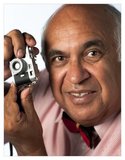
Join us for a conversation of First Nations photographers with Uncle Mervyn Bishop, Prof. Wayne Quilliam, Aunty Barbara McGrady, Tiffany Garvie, Michael Jalaru Torres, and Tamati Smith. The conversation will be facilitated by Ian RT Colless from the National Gallery of Australia.
This event is free to attend, but bookings are essential.
For those unable to make it to Canberra for the talk, it will be available to view online via the Library's Facebook and YouTube pages. You do not need to book a ticket to watch the event online.
About Deadly Dialogues
Deadly Dialogues is a series of in-conversation events that celebrates First Nations photographers, artists and creatives.
This second iteration of the series has been sparked by the current Viewfinder: Photography from the 1970s to Now exhibition.
About the speakers
Mervyn Bishop

Mervyn Bishop grew up in Brewarrina and took his first photographs at age 11 with a camera borrowed from his mother. He quickly fell in love with photography, learning how to process film and watch the 'magic' of a print emerging in a tray of developer. Bishop went to high school in Dubbo. Some of his school expenses were met by a group of editors at The Sydney Morning Herald, leading in 1963 to a successful audition to be a trainee, becoming Australia’s first Aboriginal news photographer. In 1971, Bishop was named Australian news photographer of the year for Life and Death Dash, a dramatic image of a nursing sister urgently carrying a boy suspected of swallowing dangerous drugs. After being denied the typical pay increase given other photographers who had won such awards, Bishop joined the Department of Aboriginal Affairs in Canberra in 1974 as a photographer. In this role he took one of Australia’s great iconic images of the 20th century, the 1975 photograph of Prime Minister Gough Whitlam pouring sand into the hand of Vincent Lingiari as part of a historic return of land to the Gurindji people in the Northern Territory.
In 1979 Bishop returned to The Sydney Morning Herald, but the arrangement proved an unhappy one. His subsequent freelance work and teaching at Tranby College and Eora Centre in Redfern brought him into contact with the Sydney arts scene, leading to his first solo show: In Dreams: Mervyn Bishop Thirty Years of Photography 1960–1990. Curated by artist Tracey Moffatt, the 1991 exhibition at the Australian Centre for Photography in Sydney surveyed memorable images from his personal and professional archive and later toured nationally and in England. However, the opening night will be forever intertwined with the death earlier that day of Bishop’s wife Elizabeth from cancer. In 2000, Bishop was awarded the Red Ochre award by the Australia Council for lifetime achievement in the arts by an Indigenous person. Bishop’s life story was celebrated in Flash Blak at the Sydney Opera House in 2004, billed as a journey through words, music and photographs. His later work is dominated by portraiture that demonstrates his ability to put people at ease and a sympathetic appreciation for the human condition. Examples include Sydney Elders: Portraits of Aboriginal and Torres Strait Islander Elders, shown at the Australian Museum in 2012. The Art Gallery of New South Wales honored Bishop’s 'contribution to art and photojournalism over half a century' with its 2017 exhibition simply titled Mervyn Bishop. A traveling version of this show continues to tour regionally, most recently visiting Bishop’s hometown of Brewarrina. Since 2017, Bishop has lived in Dubbo, near his sister and daughter, and he enjoys the occasional round of golf.
Ian RT Colless

Ian RT Colless is member of the Dharabuladh (Therabluat) clan of the Gundungurra people, and a mixture of Irish heritage, and the grandson of the late Aunty Dawn Colless. Ian is a member of the Australian Capital Territory’s Minister for the Arts’ Creative Council, an Advisor to the Minister for the Arts, and is involved in the assessment of grants, fellowships and scholarships with the American Australian Association (USA) & Regional Arts New South Wales (NSW). He is also a member of the Australian Community Committee and has a strong involvement with the Blue Mountains World Heritage Institute, along with other commitments across communities, sectors, industries and cultures. Ian has an unstoppable interest in world indigenous cultures, particularly with experiences choreographing for the United Nations Permanent Forum on Indigenous Issues, New York City.
Ian, a graduate of Newtown High School of the Performing Arts. He holds a Bachelor of Fine Arts from Queensland University of Technology’s (QUT) Creative Industries, a Bachelor of Arts (1st Class Honours) from Edith Cowan University’s Western Australian Academy of the Performing Arts (WAAPA) and a Masters of Arts (1st Class Masters) from New York University’s (NYU) Steinhardt School of Culture Education & Human Development. At NYU completed an Independent Study and designed a curriculum, through full-time study, coursework & participation with the American Ballet Theatre and observation of The Jacqueline Kennedy Onassis School. Ian is a recent graduate of Harvard Business School’s Executive Education’s Strategic Agility Program. He has been a Choreographer in Residence at NAISDA Dance College and artist in Residence at Performing Arts Forum in France and the Banff Centre for Arts & Creativity in Canada.
Ian has taught at NYU, QUT, WAAPA, Aboriginal Centre of Performing Arts (ACPA), The University of Sydney, University of Technology Sydney, Sydney Dance Company Pre-Professional Year and NAISDA Dance College. His formal education and professional experiences around the globe have seen expertise to design, lead, manage and deliver programs, workshops, resources, syllabus and curriculum to a variety of populations and mixed demographics internationally. At Arts NSW, Ian was involved in implementing (Stage Two) of the NSW Aboriginal Arts & Cultural Strategy (2015 – 2018) into the sector. He was the Director & Facilitator of the Custodianship Program, involved in designing this cultural leadership program for the Australia Council for the Arts (the Council) and led the development of the Council's First Nations Digital Culture and Arts Strategy which is about to be implemented in the coming months. Ian currently works with the National Gallery of Australia, as the Wesfarmers Indigenous Arts Leadership Program Coordinator.
Tiffany Garvie

Tiffany Garvie is a Gunggari women, her mother’s family are from South Central Queensland around Mitchell and the Maranoa River. Tiffany grew up on Yolngu country in Arnhem Land in the mining town of Nhulunbuy. With a background as an ABC trained radio broadcaster and producer, she has worked in mainstream and First Nations media, as well as corporate communications and marketing. Known as an events, landscape and portrait photographer, Tiffany has a passion for telling stories in images. She was a finalist in the National Photographic Portrait Prize in 2018, and is a Koorie Heritage Art Show RMIT Award winner. She has been a regular on the Melbourne events scene for a number of years shooting for clients such as the Melbourne Theatre Company, Ilbijerri Theatre Company, Clemenger BBDO and many others. With a portfolio that ranges from classic portraits to abstract macro landscapes. From archival documentary to First Nations cultural events, Tiffany’s work is as diverse as her interest in the world around her. She now calls Naarm home.
Tamati Smith

Tamati Smith is a Yamaji/Maori (Wajarri/Badimaya and Ngapuhi) man born in Port Hedland Western Australia. Spent his very early childhood in South Hedland before moving to Geraldton where he would spend a lot of my time closer to his mother’s country. Before entering the world of photography, Tamati went from the Geraldton Aboriginal Medical Service to the mining industry, and then into the Royal Australian Navy where he served for 7 years. It was during his time in the Navy that he began to make his culture and identity a priority.
Much like many others trying to find ways to occupy time during the pandemic, Tamati Smith picked up a camera for the first time. One of the first events that really kicked off his photographic journey was the 2020 Black Lives Matter rallies in Sydney. From that moment, Tamati Smith started attending as many events and rallies as he could in order to photograph them. With the support and encouragement of fellow photographer Michael Torres, Tamati Smith joined a photographic collective of like-minded black photographers, and since then he has been able to photograph many large events in Australia.
Michael Jalaru Torres

Michael Jalaru Torres is a Djugun-Yawuru man from Broome, Western Australia, with tribal connections to the Gooniyandi/Jabbir Jabbir/Ngarluma peoples. He is a fine art photographer, poet, creator of design and video art, and a media professional. Michael finds inspiration in the unique landscapes and people of the Kimberley region, which feature prominently in his work. His photography draws on his own stories and personal history, and explores contemporary social and political issues facing Indigenous people.
Much of Michael's work involves conceptual and innovative portraiture, and abstract landscape photography. He is a self-taught photographer and was drawn to photography as a visual medium because of its accessibility and the challenge of capturing stories in single images. Michael experiment regularly with different mediums, and is interested in expanding his photography into installations and motion work and pushing the boundaries of how conceptual photography can be used in virtual reality. His photography has appeared in exhibitions in China, Germany, Sydney, Melbourne, Perth and regional Western Australia.